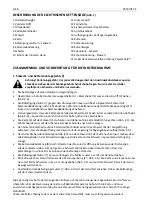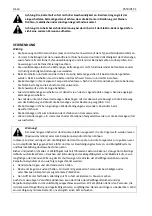
PATRIOT
PS
EN
‐
11
d)
Limbing
a
Tree
Limbing
is
removing
the
branches
from
a
fallen
tree.
When
limbing,
leave
larger
lower
limbs
to
support
the
log
off
the
ground.
Remove
the
small
limbs
in
one
cut
as
illustrated
in
Figure
4
‐
C.
Branches
under
tension
should
be
cut
from
the
bottom
up
to
avoid
binding
the
chain
saw.
e)
Bucking
a
Log
Bucking
is
cutting
a
log
into
lengths.
It
is
important
to
make
sure
your
footing
is
firm
and
your
weight
is
evenly
distributed
on
both
feet.
When
possible,
the
log
should
be
raised
and
supported
by
the
use
of
limbs,
logs
or
chocks.
Follow
the
simple
directions
for
easy
cutting.
When
the
log
is
supported
along
its
entire
length
as
illustrated
in
Figure
4
‐
D,
it
is
cut
from
the
top
(over
‐
buck).
When
the
log
is
supported
on
one
end,
as
illustrated
in
Figure
4
‐
E,
cut
1/3
the
diameter
from
the
underside
(underbuck).
Then
make
the
finished
cut
by
overbucking
to
meet
the
first
cut.
When
the
log
is
supported
on
both
ends,
as
illustrated
in
Figure
4
‐
F,
cut
1/3
of
that
diameter
from
the
top
overbruck.
Then
make
the
finished
cut
by
underbucking
to
meet
the
first
cut.
When
bucking
on
a
slope
always
stand
on
the
uphill
side
of
the
log,
as
illustrated
in
Figure
4
‐
G.
When
“cutting
through”,
to
maintain
complete
control
release
the
cutting
pressure
near
the
end
of
the
cut
without
relaxing
your
grip
on
the
chain
saw
handles.
Don’t
let
the
chain
contact
the
ground.
After
completing
the
cut,
wait
for
the
saw
chain
to
stop
before
you
move
the
chain
saw.
Always
stop
the
motor
before
moving
from
tree
to
tree.
Spiked
Bumper
(Fig.
4
‐
H)
Dig
the
spiked
bumper
(12)
into
the
log
and
use
it
as
a
pivot.
Cut
with
an
arched
motion
to
make
the
bar
penetrate
the
wood.
Repeat
several
times
if
necessary,
changing
the
point
where
you
plant
the
spiked
bumper.
MAINTENANCE,
SERVICING
AND
STORING
Warning!
Risk
of
injury.
Before
performing
any
maintenance
operation
unplug
the
power
cord
from
the
wall
socket.
Warning:
Other
maintenance
and
repair
work
than
those
listed
in
this
manual,
must
only
be
performed
by
an
authorized
manufacturer's
service.
When
cable
break
this
tool
may
lead
replaced
only
by
authorized
service
manufacturer,
as
it
will
need
special
tools.
Safety
and
operational
reliability
can
only
be
guaranteed
when
using
original
spare
parts.
After
each
use,
clean
the
chain
saw
from
dust
and
oil
by
the
brush
and
cloth.
Especially
careful
to
ensure
that
the
ventilation
openings
on
the
motor
housing
are
clean
(danger
of
overheating)
–
Fig.
5
‐
G.
Do
not
use
harsh
chemicals,
abrasives,
etc.
This
could
cause
damage
to
the
saw.
Check
after
each
use
all
the
parts
of
wear
on
chain
saws,
especially
chain,
bar
and
sprocket.
After
use
the
saw,
especially
the
engine
cover
and
the
power
cord
for
damage.
When
the
sign
of
damage
check
chain
saw
inspected
and
repaired
by
an
authorized
service
department.
Check
after
each
use
chain
saw
delete
function.
Dysfunctional
lubrication
leads
to
damage
to
the
chain,
bar
and
motor.
In
the
case
of
intensive
use,
it
is
recommended
to
let
the
saw
annually
inspected
by
an
authorized
manufacturer's
service
center.
For
normal
use,
then
every
two
years.
Only
when
using
bio
‐
oil
for
the
chain:
because
some
kinds
of
bio
‐
oil
after
a
long
time
may
change
the
consistency
(gels),
should
be
oil
system
chain
saw
cleaned
before
storage.
Completely
empty
the
oil
tank,
then
run
briefly
sawmill,
and
empty
and
the
oil
line.
Then
remove
the
bar
and
chain
and
wipe
off
excess
oil
from
the
outer
surfaces
of
saws
and
bars.
Chain
recommend
to
put
into
a
container
with
mineral
oil.
Before
using
a
new
chain
saw
must
necessarily
re
‐
pour
the
oil
and
mount
the
chain
and
bar.
















































